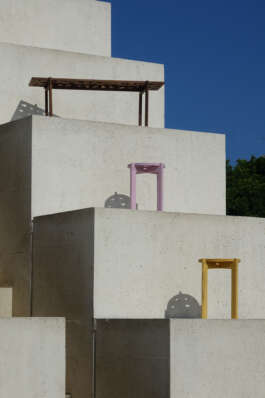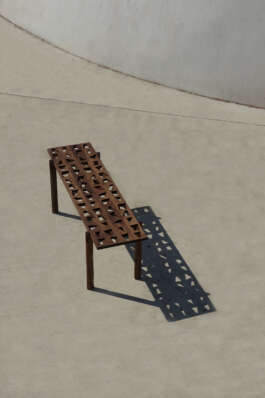



© frill furniture
COLLECTIBLE In-Depth
frill furniture
August 2024
This series, COLLECTIBLE In-Depth, unveils the backstage of contemporary creation. Tackling various topics from personal designer processes to the position of collectible design on the global design market, COLLECTIBLE In-Depth offers different views to suit all tastes. Today we speak with frill furniture.
C: How did you get into collectible design? Why did you focus your practice on this type of design rather than industrial design?
frill furniture: I studied woodworking, and I was a craftswoman first. The desire to design emerged from within the craft, from a need to create my own language and give it expression in bespoke items.
Being part of the collectible world allows me to push myself creatively. I want to make objects that become a part of the customers’ story, that evolve with their life. For that to happen, these objects need to be interesting and bring joy. I want to contribute to spaces that have something unexpected in every corner, as opposed to mass-produced objects that tend to be more demure.
C: Can you talk about a new piece that you’re releasing at COLLECTIBLE this year?
ff: For COLLECTIBLE, I played around with color. I created two cutout side tables in a color combination that felt surprising to me. The tables are made of solid ash wood that I dipped in diluted dye, making sure that the natural wood grain and woodworking details are visible.
C: Can you talk about an interior designer you dream to work with?
ff: I admire the overwhelmingly playful interior worlds created by Jaime Hayon.
C: When designing a collectible object how do you think about the various environments where it can end up?
ff: I like creating pieces that have an intimate relationship with the space they’re in. I tend to perforate my furniture and that means you can see through it. You can see the floor underneath, and walls behind it. The shadows add another facet to the space. Each object undergoes a little transformation based on where it is placed.
On the technical level, wood is a living material that expands and contracts and changes color, and I take that into account since I cannot control which climates the furniture travels through in its lifetime (in fact, I hope my pieces get to see the world).
C: How do you question or challenge functionality in your design process?
ff: The fact that all my pieces have holes in them comes at the expense of functionality, but that just requires a little courage on the part of the person who brings them into their home.
Sure, a solid traditional table top may allow you to be more precarious with your coffee cup, but where’s the fun in that? Furniture takes up so much of our living space and there’s no reason it shouldn’t also be quirky.

© frill furniture

© frill furniture

© frill furniture
COLLECTIBLE In-Depth
frill furniture
August 2024
This series, COLLECTIBLE In-Depth, unveils the backstage of contemporary creation. Tackling various topics from personal designer processes to the position of collectible design on the global design market, COLLECTIBLE In-Depth offers different views to suit all tastes. Today we speak with frill furniture.
C: How did you get into collectible design? Why did you focus your practice on this type of design rather than industrial design?
frill furniture: I studied woodworking, and I was a craftswoman first. The desire to design emerged from within the craft, from a need to create my own language and give it expression in bespoke items.
Being part of the collectible world allows me to push myself creatively. I want to make objects that become a part of the customers’ story, that evolve with their life. For that to happen, these objects need to be interesting and bring joy. I want to contribute to spaces that have something unexpected in every corner, as opposed to mass-produced objects that tend to be more demure.
C: Can you talk about a new piece that you’re releasing at COLLECTIBLE this year?
ff: For COLLECTIBLE, I played around with color. I created two cutout side tables in a color combination that felt surprising to me. The tables are made of solid ash wood that I dipped in diluted dye, making sure that the natural wood grain and woodworking details are visible.
C: Can you talk about an interior designer you dream to work with?
ff: I admire the overwhelmingly playful interior worlds created by Jaime Hayon.
C: When designing a collectible object how do you think about the various environments where it can end up?
ff: I like creating pieces that have an intimate relationship with the space they’re in. I tend to perforate my furniture and that means you can see through it. You can see the floor underneath, and walls behind it. The shadows add another facet to the space. Each object undergoes a little transformation based on where it is placed.
On the technical level, wood is a living material that expands and contracts and changes color, and I take that into account since I cannot control which climates the furniture travels through in its lifetime (in fact, I hope my pieces get to see the world).
C: How do you question or challenge functionality in your design process?
ff: The fact that all my pieces have holes in them comes at the expense of functionality, but that just requires a little courage on the part of the person who brings them into their home.
Sure, a solid traditional table top may allow you to be more precarious with your coffee cup, but where’s the fun in that? Furniture takes up so much of our living space and there’s no reason it shouldn’t also be quirky.

© frill furniture

© frill furniture
Contact
info@collectible.design
VIP PORTAL
EXHIBITOR PORTAL
PRIVACY POLICY
© 2025 Collectible
Contact
info@collectible.design
VIP PORTAL
EXHIBITOR PORTAL
PRIVACY POLICY
© 2025 Collectible